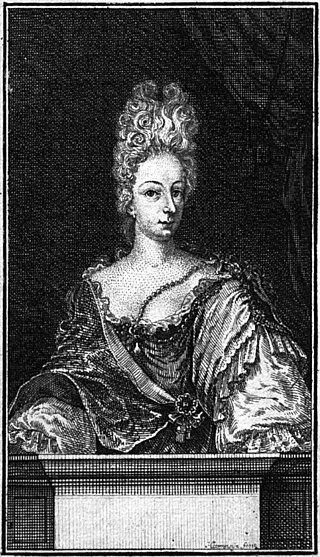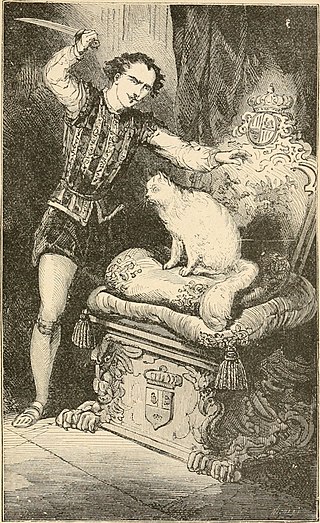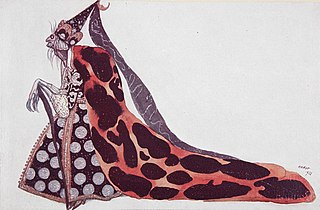Related Research Articles

In fairy tales, a fairy godmother is a fairy with magical powers who acts as a mentor or parent to someone, in the role that an actual godparent was expected to play in many societies. In Perrault's Cinderella, he concludes the tale with the moral that no personal advantages will suffice without proper connections.

Marie-Catherine Le Jumel de Barneville, Baroness d'Aulnoy, also known as Countess d'Aulnoy, was a French author known for her literary fairy tales. The term contes de fées has been attributed to her, but her work was called "contes DES fées" ; the term "contes DE fées" comes from Mme de Murat's first fairytale compilation: "Contes de fées", published in 1698.

Henriette-Julie de Murat was an aristocratic French writer of the late 17th century, associated with the Baroque Précieuses movement, and one of the leading members of the French Salons who created the fairy tale genre.

"The Blue Bird" is a French literary fairy tale by Madame d'Aulnoy, published in 1697. An English translation was included in The Green Fairy Book, 1892, collected by Andrew Lang.

The grey Cat is a French literary fairytale written by Madame d'Aulnoy and published in 1698. Andrew Lang included it in The Blue Fairy Book.
Princess Rosette is a French literary fairy tale written by Madame d'Aulnoy. Andrew Lang included it in The Red Fairy Book.

Princess Belle-Etoile is a French literary fairy tale written by Madame d'Aulnoy. Her source for the tale was Ancilotto, King of Provino, by Giovanni Francesco Straparola.
The Princess Mayblossom is a French literary fairy tale written by Madame d'Aulnoy in 1697. Andrew Lang included it in The Red Fairy Book.

Graciosa and Percinet is a French literary fairy tale by Madame d'Aulnoy. Andrew Lang included it in The Red Fairy Book.
"The Pig King" or "King Pig" is an Italian literary fairy tale written by Giovanni Francesco Straparola in his The Facetious Nights of Straparola. Madame d'Aulnoy wrote a French, also literary, variant, titled Prince Marcassin.

Finette Cendron is a French literary fairy tale written by Madame d'Aulnoy.

The Bee and the Orange Tree is a French literary fairy tale by Madame d'Aulnoy.
Babiole is a French literary fairy tale, written by Madame d'Aulnoy. In English publications, the name is sometimes translated as Babiola.
Belle-Belle ou Le Chevalier Fortuné is a French literary fairy tale, written by Madame d'Aulnoy.

The Wicked fairy is the antagonist of Sleeping Beauty. In some adaptations, she is known as Carabosse. The most notable adaptation of the character is Maleficent, a Disney villain who appeared in various Disney media, beginning with the 1959 Walt Disney film Sleeping Beauty.
The Imp Prince is a French fairy tale written by Marie Catherine d'Aulnoy and published in her book Fairy Tales in 1697.
Bearskin is a French literary fairy tale by Marie-Madeleine de Lubert. It was included in her revised edition, published in 1753, of Henriette-Julie de Murat's last novel, Les Lutins du château de Kernosy, which is why it is often attributed to Madame Henriette-Julie de Murat.
Starlight or Starlet is a French literary fairy tale by Marie-Madeleine de Lubert. It was included in her revised edition, published in 1753, of Henriette-Julie de Murat's last novel, Les Lutins du château de Kernosy, which is why it is often attributed to Madame de Murat.
Costanza / Costanzo is an Italian literary fairy tale written by Giovanni Francesco Straparola in The Facetious Nights of Straparola.
The Three Crowns is an Italian literary fairy tale written by Giambattista Basile in his 1634 work, the Pentamerone.
References
- ↑ Marie Catherine Baronne D'Aulnoy. "The Dolphin" The Fairy Tales of Madame D'Aulnoy'Miss Annie Macdonell and Miss Lee, translators. London: Lawrence and Bullen, 1892.
- ↑ Jack Zipes, The Great Fairy Tale Tradition: From Straparola and Basile to the Brothers Grimm, p 100, ISBN 0-393-97636-X
- ↑ Paul Delarue, The Borzoi Book of French Folk-Tales, p 389-90, Alfred A. Knopf, Inc., New York 1956
- ↑ Reddan, Bronwyn. "Scripting Love in Fairy Tales by Seventeenth-Century French Women Writers". In: French History and Civilization 7, 2016 Seminar (2017): 96-97.
- ↑ Patard, Geneviève “Madame de Murat et les fées modernes”. In: The Romanic Review vol. 99, numéro 3–4 (May. 2008): p. 274 and footnote nr. 10.
- ↑ Trinquet, Charlotte. Le conte de fées français (1690-1700): Traditions italiennes et origines aristocratiques. Narr Verlag. 2012. pp. 89, 104 (footnorte nr. 119), 143-149. ISBN 978-3-8233-6692-8
- ↑ The Pleasant Nights. Volume 1. Edited by Beecher Donald, by Waters W.G. Toronto; Buffalo; London: University of Toronto Press, 2012. pp. 59, 378 (footnotre nr. 5). Accessed March 14, 2021. http://www.jstor.org/stable/10.3138/9781442699519.4.
- ↑ Hofmann, Melissa (2014). "The Fairy as Hero(ine) and Author: Representations of Female Power in Murat's "Le Turbot".". In: Marvels & Tales 28. pp. 252-277.